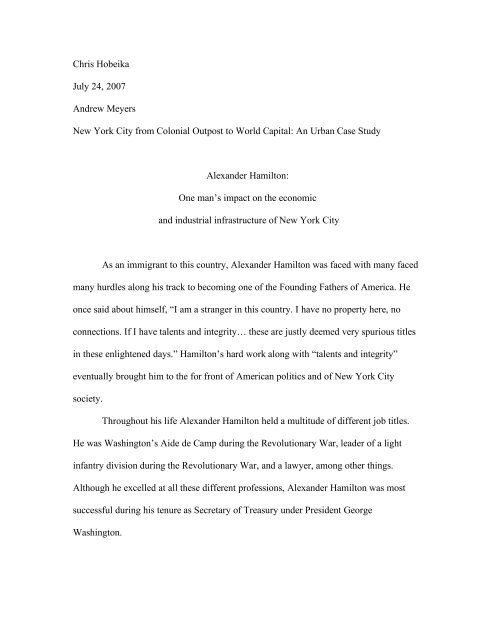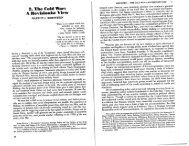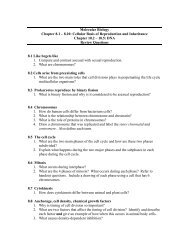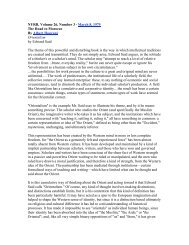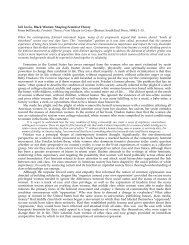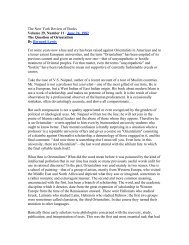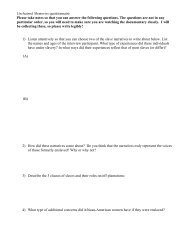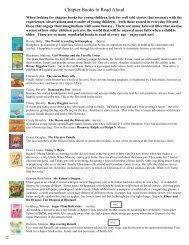Chris Hobeiko's essay on Hamilton
Chris Hobeiko's essay on Hamilton
Chris Hobeiko's essay on Hamilton
You also want an ePaper? Increase the reach of your titles
YUMPU automatically turns print PDFs into web optimized ePapers that Google loves.
<str<strong>on</strong>g>Chris</str<strong>on</strong>g> HobeikaJuly 24, 2007Andrew MeyersNew York City from Col<strong>on</strong>ial Outpost to World Capital: An Urban Case StudyAlexander Hamilt<strong>on</strong>:One man’s impact <strong>on</strong> the ec<strong>on</strong>omicand industrial infrastructure of New York CityAs an immigrant to this country, Alexander Hamilt<strong>on</strong> was faced with many facedmany hurdles al<strong>on</strong>g his track to becoming <strong>on</strong>e of the Founding Fathers of America. He<strong>on</strong>ce said about himself, “I am a stranger in this country. I have no property here, noc<strong>on</strong>necti<strong>on</strong>s. If I have talents and integrity… these are justly deemed very spurious titlesin these enlightened days.” Hamilt<strong>on</strong>’s hard work al<strong>on</strong>g with “talents and integrity”eventually brought him to the for fr<strong>on</strong>t of American politics and of New York Citysociety.Throughout his life Alexander Hamilt<strong>on</strong> held a multitude of different job titles.He was Washingt<strong>on</strong>’s Aide de Camp during the Revoluti<strong>on</strong>ary War, leader of a lightinfantry divisi<strong>on</strong> during the Revoluti<strong>on</strong>ary War, and a lawyer, am<strong>on</strong>g other things.Although he excelled at all these different professi<strong>on</strong>s, Alexander Hamilt<strong>on</strong> was mostsuccessful during his tenure as Secretary of Treasury under President GeorgeWashingt<strong>on</strong>.
Alexander Hamilt<strong>on</strong>’s expansive and logical ec<strong>on</strong>omic mind helped him tosucceed so prodigiously during his short life. His firm belief that an emulati<strong>on</strong> of Englandin America, al<strong>on</strong>g with a few tweaks, led to federal government we see today. Hisunderstanding that <strong>on</strong>ly through manufacturing would America become and world powerlead to the creati<strong>on</strong> of an industrial nati<strong>on</strong>, sustained by agriculture that we see today,instead of the creati<strong>on</strong> of a purely Agriculture nati<strong>on</strong> which would have left Americanbehind in the Global world.Alexander Hamilt<strong>on</strong>’s ec<strong>on</strong>omic and industrial programs are the reas<strong>on</strong>s whyNew York City was the industrial capital of the world, until recently, and why New YorkCity is the ec<strong>on</strong>omic and financial capitol of the world today.Hamilt<strong>on</strong> first became aware of the need for ec<strong>on</strong>omic reform during theAmerican Revoluti<strong>on</strong>. At that time the United States was heavily indebted to foreigncountries, private investors, and owned a tremendous amount of back pay to soldiers whofought for the C<strong>on</strong>tinental Army and soldiers who fought in state militia. The countriesfinances were so bad in fact that at <strong>on</strong>e point James Madis<strong>on</strong> wrote to Thomas Jeffers<strong>on</strong>,“Believe me, sir, as things now stand, if the sates do not vigorously proceed in collectingthe old m<strong>on</strong>ey and establishing funds, for the credit of the new… we are und<strong>on</strong>e.” Keepin mind that latter in Alexander Hamilt<strong>on</strong>’s life, Thomas Jeffers<strong>on</strong>, al<strong>on</strong>g with JamesMadis<strong>on</strong> would provide the staunchest oppositi<strong>on</strong> to Hamilt<strong>on</strong>’s plans for the country andthat even they were aware that something needed to be changed.The first time Alexander Hamilt<strong>on</strong> voiced his views <strong>on</strong> finance was towards theend of the Revoluti<strong>on</strong>ary War in a letter to Robert Morris, who was at that time wassuperintendent of finance to the c<strong>on</strong>tinental c<strong>on</strong>gress. On April 20, 1781, Alexander
Hamilt<strong>on</strong> sent a 31 page letter to Morris. In this letter he outlined his ideas <strong>on</strong> how to setup a system that would give American lower credit and he sited the needs for a Nati<strong>on</strong>alBank. Both of these views he would latter bring to the table as secretary of treasury underGeorge Washingt<strong>on</strong>, and in his first and sec<strong>on</strong>d reports <strong>on</strong> Public Credit. Hamilt<strong>on</strong>’sletter showed that even though, in his own words, he was “not an able financier” he wasable to use his immense intellect to form c<strong>on</strong>crete ideas that would eventually serve asthe basis for Americans financial programs.Hamilt<strong>on</strong> firmly believes that in order to win the war, American must “introduceorder into our finances- by restoring public credit to finally gain our object”; the objectbeing freedom. His soluti<strong>on</strong> to the budget deficit was a nati<strong>on</strong>al bank similar to the banksof rich European nati<strong>on</strong>s that would enhance state power and facilitate private commerce.His emulati<strong>on</strong>s of British belief would eventually gain him much criticism in the futureby followers of Jeffers<strong>on</strong>.During the Revoluti<strong>on</strong>, Hamilt<strong>on</strong> also began to first voice his views <strong>on</strong> theweakness of the central government and <strong>on</strong> the power of the states. This would becomeextremely important after the war, when Hamilt<strong>on</strong>, al<strong>on</strong>g with Madis<strong>on</strong> helped facilitatethat C<strong>on</strong>stituti<strong>on</strong>al C<strong>on</strong>venti<strong>on</strong>, the creating of the C<strong>on</strong>stituti<strong>on</strong> of the United States ofAmerica, and New York’s acceptance of the C<strong>on</strong>stituti<strong>on</strong>.However, before working with Hamilt<strong>on</strong> <strong>on</strong> the C<strong>on</strong>stituti<strong>on</strong>, they first created acampaign to introduce a 5 percent duty <strong>on</strong> all imports. This would give C<strong>on</strong>gressaut<strong>on</strong>omy in m<strong>on</strong>ey matters and would hedge the growing powers of the states. AlthoughHamilt<strong>on</strong> was fiercely loyal to New York City, he still felt that the Federal government
needed more power and was willing to curb the powers of his State, and City in-order topreserve the newly founded country.According to historian R<strong>on</strong> Chernow, “no individual (Hamilt<strong>on</strong>) was identifiedmore with the postwar resurgence of New York City – not to menti<strong>on</strong> the city’s futuregreatness- than Alexander Hamilt<strong>on</strong>. He was destined to excel in what was to emerge asAmerica’s commercial and financial metropolis and he articulated the most expansivevisi<strong>on</strong> of its future.” However for all his love of New York City and his craving that itwould eventually become the capitol of the United States, and eventually the world,Hamilt<strong>on</strong> did make mistakes when it came to the future of New York City namely, hisinvestments in upstate New York instead of New York City.Alexander Hamilt<strong>on</strong>’s first c<strong>on</strong>tributi<strong>on</strong> to New York City came directlyfollowing the Revoluti<strong>on</strong>ary War. After the treaty of Paris was signed, the city changedfrom British rule to American rule. Many returning patriots were hungry for loyalistblood. However Alexander realized that removing the loyalists from New York Citywould be disastrous for the ec<strong>on</strong>omy of New York City. Firstly, because New York Cityhad such a large base of Tories, it would remove much of the populati<strong>on</strong>. Sec<strong>on</strong>dly, theLoyalists for the most part were the rich aristocratic landlords. If the die hard patriotswere to succeed in removing all loyalists from the city, it would surely be disastrous.Because he was a lawyer, Hamilt<strong>on</strong> was well suited to help the City negotiate thepassage from English military rule to that of the sober rule of law. Hamilt<strong>on</strong> helpedLoyalists, who were often rich Anglican merchants and members of the social elite intheir legal battles. Hamilt<strong>on</strong> also fought for the Tories because he wanted America to bemore respectable in the eyes of the British. John Jay gave him advice, c<strong>on</strong>cerning France.
“The Tories are almost as much pities in these countries as they are execrated in ours. Anundue degree of severity towards them would therefore be impolitic as well asunjustifiably.” Destructi<strong>on</strong> and seizure of Tory property also violated the treaty of Pariswhich could have incited a British renewal to war.Alexander Hamilt<strong>on</strong>’s defense of the rich, aristocratic Tory land owners in theNew York Courts immediately following the Revoluti<strong>on</strong>ary War helped to stop a lot ofthe capitol New York City had from leaving. Eventually this would turn out to be veryhelpful for Hamilt<strong>on</strong> and for the City because these Tories, al<strong>on</strong>g with Hamilt<strong>on</strong> andother patricians of New York City upper society would facilitate the creati<strong>on</strong> of the Bankof New York, al<strong>on</strong>g with the precursor to the New York City Stock exchange.In 1783, Jeremiah Wadsworth and Alexander Hamilt<strong>on</strong>’s brother in low, John B.Church gave Hamilt<strong>on</strong> the task of setting up a Private bank in New York City. Hamilt<strong>on</strong>readily accepted the challenge because he felt that a bank would help to reinvigorate NewYork City commerce and finance. Hamilt<strong>on</strong> felt that the best bank would be ac<strong>on</strong>servative bank that would c<strong>on</strong>duct business exclusively in notes and gold and silvercoins. He received oppositi<strong>on</strong> from Robert R. Livingst<strong>on</strong> who though a land bank wouldbe better. A land bank is a bank in which the initial capital is pledged in the form of land.Hamilt<strong>on</strong> thought this idea to be “wild and impracticable.Hamilt<strong>on</strong>, with the banking of New York Cities merchants, stymied Livingst<strong>on</strong>’ssolicitati<strong>on</strong>s of the New York legislature for a land bank charter. Hamilt<strong>on</strong> waseventually placed <strong>on</strong> the board of the new Bank of New York; however he <strong>on</strong>lyrequisiti<strong>on</strong>ed <strong>on</strong>e single share of the bank. In the New-York Packet, the gathering of thefirst bankers was recorded <strong>on</strong> February 23, 1784: “It appearing to be the dispositi<strong>on</strong> of
the gentlemen in this city to establish a bank <strong>on</strong> liberal principles… they are thereforehereby invited to meet tomorrow evening at six o’clock at the Merchants Coffee House,where a plan will be submitted to their c<strong>on</strong>siderati<strong>on</strong>.” Hamilt<strong>on</strong> was voted director ofthis bank and over the next three weeks drafted a c<strong>on</strong>stituti<strong>on</strong> for it. He also received a50,000 dollar loan from the Federal Government for the bank. This c<strong>on</strong>stituti<strong>on</strong> was usedas the pattern for many subsequent bank charters and helped to define American banking.The creati<strong>on</strong> of the bank created much criticism. New Yorkers who lived upstatewanted a land bank and thought that a m<strong>on</strong>ey bank would <strong>on</strong>ly benefit the urban elite, thevery same loyalists for whom Hamilt<strong>on</strong> fought for prior to the creati<strong>on</strong> of the bank.However despite the misgivings of these people, the bank rec<strong>on</strong>ciled the Patriots andLoyalist within the city who wanted to the bank to succeed. The bank also introducedorder into the American currency. Currently, the bank is the oldest stock traded <strong>on</strong> theNew York Stock Exchange.Aside from the purely ec<strong>on</strong>omic c<strong>on</strong>tributi<strong>on</strong>s Hamilt<strong>on</strong> gave to New York City,he also c<strong>on</strong>tributed to many local instituti<strong>on</strong>s. He created the Board of Regents, whichhelped to improved educati<strong>on</strong> in the state. He was a trustee to Columbia College,formerly Kings College of which he was a graduate. He helped to relive traffic in lowerNew York City by moving statues as well.During his tenure as Secretary of the Treasury Hamilt<strong>on</strong> began issuing b<strong>on</strong>dsfrom the Federal Government. The main place for selling these b<strong>on</strong>ds was within NewYork City. At the <strong>on</strong>set these b<strong>on</strong>ds, sold in the securities market, sky rocketed in price.However there were many corrupt price gougers in this business. B<strong>on</strong>ds could be riggedby swindlers planting false rumors and exploiting the aucti<strong>on</strong> system, similar to the pump
and dump techniques of many <strong>on</strong>line investors in today’s market place. In order tocounter this corrupti<strong>on</strong>, Hamilt<strong>on</strong> moved to aid in the creati<strong>on</strong> of a more orderly way oftrading.On May 17, 1792, at the bequest of Hamilt<strong>on</strong> 24 brokers gathered at 60 wallstreet, under a Butt<strong>on</strong> Wood Tree. The agreement they made there, henceforth called thebutt<strong>on</strong>wood agreement, reads as follows: We the Subscribers, Brokers for the Purchaseand Sale of the Public Stock, do hereby solemnly promise and pledge ourselves to eachother, that we will not buy or sell from this day for any pers<strong>on</strong> whatsoever, any kind ofPublic Stock, at least than <strong>on</strong>e quarter of <strong>on</strong>e percent Commissi<strong>on</strong> <strong>on</strong> the Specie valueand that we will give preference to each other in our Negotiati<strong>on</strong>s. In Testim<strong>on</strong>y whereofwe have set our hands this 17 th day of May at New York, 1792.” This agreement was theprecursor of the New York Stock Exchange, a 9 trilli<strong>on</strong> dollar industry, which is in manyrespects the life line of New York Cities Success to this day.Alexander Hamilt<strong>on</strong>’s brilliant, logical, and ec<strong>on</strong>omic mind helped to create thefinancial and ec<strong>on</strong>omic capitol of the world, New York City. His defense of LoyalistsNew Yorkers, helped to retain the “Knickerbockers” society of New York City, whichwould become the leaders of this city. His creati<strong>on</strong> of the Bank Of New York stabilizedAmerican currency, created trust in the American market, and helped to develop NewYork City as a trading center. The Butt<strong>on</strong>wood agreement is in fact the New York Stockexchange. Without it New York City would be undeniably less great. AlexanderHamilt<strong>on</strong>’s many c<strong>on</strong>tributi<strong>on</strong>s to the City of New York have helped to make it what it istoday; <strong>on</strong>e can <strong>on</strong>ly w<strong>on</strong>der how much greater the city would be today if his life was notcut short by his infamous duel with Aar<strong>on</strong> Burr.
Works Cited1. Chernow, R<strong>on</strong>. Alexander Hamilt<strong>on</strong>. New York. The Penguin Press. 20042. Homberger, Eric. The Historical Atlas of New York City. New York. OwlBooks. 19943. Ellis, Joseph J. Founding Brothers The Revoluti<strong>on</strong>ary Generati<strong>on</strong>. New York.Vintage Books. 2000


